DESIGNING AND TECHNOLOGY ADDING TO AN ERRATOLOGY MODEL TEACHING COMPLEX SENTENCES OF LANGUAGE SPECIALITY
Abstract
https://doi.org/10.18522/1995-0640-2025-1-174-187
The article suggests a description of the process of erratology model teaching; it reveals an author’s conception of teaching complex sentences in the context of this technology. The aim of the research is to work out author’s (erratology) model teaching students of non-philology majors the Russian language. One of the key ideas of erratology model is to teach according to the four concenters: 1) mistakes analysis (CONCENTER 1AO – identification and procedures connected to it); 2) wrking out short grammar commentaries (CONCENTER 2); 3) mistakes analysis (CONCENTER 3AO – training, test-correction); 4) creative production considering the usage of taught constructions (CONCENTER 4). The results allow to talk about that the process of teaching complex structures of the language engeenering-majors is more effective if it is possible to accept the methodological instrument a technology based on the erratology data. It will allow not only to make up a Russian language professional competence, but also to bring foreign student’s undoubted interest to learn a new language, to intensify the learning process itself, upgrade it with technologies, methods of teaching and new system of tasks.
Key words: erratology, erratology model, Russian language as a foreign, concenter, foreigners of non-philology majors, technology
Downloads
Published
How to Cite
Issue
Section
License
Copyright (c) 2025 Alan S. Tshovrebov

This work is licensed under a Creative Commons Attribution-NonCommercial 4.0 International License.
Authors who publish with this journal agree to the following terms:
- Authors retain copyright and grant the journal right of first publication with the work simultaneously licensed under a Creative Commons Attribution License that allows others to share the work with an acknowledgement of the work's authorship and initial publication in this journal.
- Authors are able to enter into separate, additional contractual arrangements for the non-exclusive distribution of the journal's published version of the work (e.g., post it to an institutional repository or publish it in a book), with an acknowledgement of its initial publication in this journal.
- Authors are permitted and encouraged to post their work online (e.g., in institutional repositories or on their website) prior to and during the submission process, as it can lead to productive exchanges, as well as earlier and greater citation of published work (See The Effect of Open Access).


















